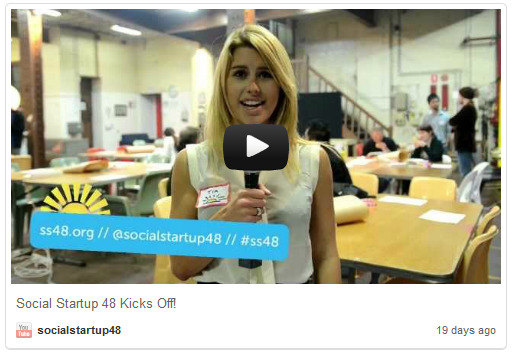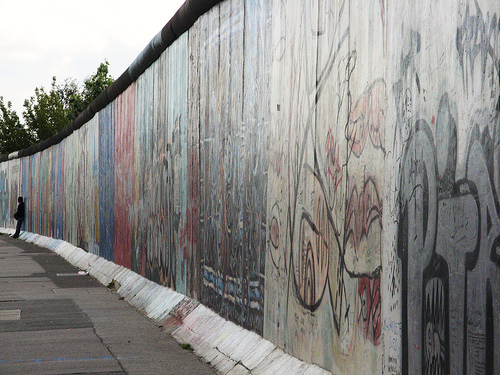 A couple of weekends ago I spent Sunday hanging out as a mentor at Social Startup 48, a Startup Weekend-style event where participants create a company from scratch over a single weekend, only for social impact. It was a fun, inspiring and thought-provoking experience and I’m thrilled to have been involved. There’s nothing I like more than participating in creating new things, working to support new changemakers to realise their vision.
A couple of weekends ago I spent Sunday hanging out as a mentor at Social Startup 48, a Startup Weekend-style event where participants create a company from scratch over a single weekend, only for social impact. It was a fun, inspiring and thought-provoking experience and I’m thrilled to have been involved. There’s nothing I like more than participating in creating new things, working to support new changemakers to realise their vision.
To my fascination the event was mildly controversial in social entrepreneurship circles in the lead-up, with push back against the announcement on the Australian Social Innovation eXchange (ASIX) website and Emerging Leaders in Social Change LinkedIn Group (members only). I threw myself vigorously into the later conversation, before I had any involvement in the event.
The issue people had with it was, largely, the slogan: “How fast can you make a difference?” Change doesn’t happen quickly they insisted, any and all change efforts require long-term study before making a move or trying anything else. Non-experts will only stuff it up. Something like that.
And of course, this is very true for many change efforts. Bringing diverse stakeholders together is often slow difficult work, as can making change inside any large institution. Building trust within community requires a long-term commitment, especially if you are from outside that community. Understanding all the dynamics of an issue (is this even possible?) and the work already done requires careful study.
But these are not the only pathways to creating change.
Social entrepreneurs are the inventors of the social change world, and just as it was for science for many hundreds of years, it is the inventors, the tinkers, those who get their hands dirty to go to work on figuring things out through action and learning, who have often created huge and innovative leaps forward in delivering social outcomes.
The point is not that one approach is better than another but that we need both. The greatest advances occur when the breakthroughs pioneered by the inventors is scaled through market mechanisms, government action or cross-sector partnerships, or by reaching a tipping point in cultural consciousness.
An event like Social Startup 48 would seem to naturally attract those drawn to the later approach, but not exclusively. Look through the list of participants and you would see researchers, academics and bureaucrats amongst their number. Working in teams to make decisions fast is an amazing learning experience no matter where you’re coming from.
It’s also true that in science the greatest breakthroughs are often earlier in people’s careers. It is the ability to see things from new angles, less encumbered by the prevailing wisdom or business-as-usual, which often (again, not always) leads to transformational breakthroughs, not experience.
So inviting newer, younger and more diverse actors to participate in creating change, however “fast” or “slow” they go about it initially, is a crucial part of creating change. We need new ideas and new participants to contribute to many wicked problems and creating more participation in our changemaking systems is a critical democratic advance in its own right.
It’s also worth thinking about what motivates people to walk the unquestionably long and hard road of affecting systemic social change. Could this motivation itself not arrive in an instance, when eyes and hearts become open to the need for change and the possibility of being involved in making it happen? In my experience many changemakers can trace their decision to commit to proactively creating the future to a specific formative event. If done right Social Startup 48 could be that experience for people and even if none of the specific ventures designed over the weekend reached any sort of scale the experience of conceiving and launching a social venture, learning about what works and what doesn’t, will inform their future endeavours. Vibewire was the third organisation I founded and StartSomeGood is my fourth. You learn most by doing.
Certainly spending Sunday afternoon hanging out in the Queen Street Studios with everyone and seeing ten very busy teams hashing out their business models, core stories and make plans for pitching gave me a lot of joy – 50-odd people prepared to spend their weekend and sacrifice their sleep to make a difference is something to be celebrated! There was an amazing buzz as teams huddled to make rapid-fire decisions then scattered to fulfill tasks: coding, shooting video, taking photos, developing a business plan, preparing the slides for their pitch, designing a logo (or organising to have four different teams logo’s designed in the case of Crowdworthy) the focus ramped up across the day as they approached the deadline or pitches to be submitted.

The pitches were well-executed and the many of the ideas were well thought-through and compelling and the progress made was very impressive overall. You can see videos of all the pitches in the storify I made and check out the Social Startup 48 ventures listed on StartSomeGood.
The collaborative consumption movement was in full swing – fully eight of the ten ventures were a platform of some kind. This was in-part a result of the rising profile of and huge untapped potential for a more collaborative approach to consumption and community-building but also, I think, a result of teams having been somewhat pre-assigned, so as to spread certain skillsets, especially technical, around the groups. I can see the logic behind this but I think a more purely self-organised approach playing out on the Friday night would result in a less equal spread of skills across teams and therefore a greater diversity of teams which would produce more diverse ideas and ventures.
There are other little tweaks and improvements I am going to suggest to the organisers, which is the whole point – you have to run an event like this to figure out what works. No amount of research or modeling would ever teach you as much as putting yourself on the line and actually organising the event, seeing who turned up and how they responded, listening to your community and learning from what happened and doing it that much better next time. Social Startup 48 gave 50 people the opportunity to take that courageous first step, without which no other steps would follow.
Congratulations to the great team behind Social Startup 48 – I hope this is the first of many ss48 events in Sydney and around the world.
To get more of a taste for the weekend along with videos of all the pitches and many of the presentations check out storify.
 I recently published this
I recently published this 